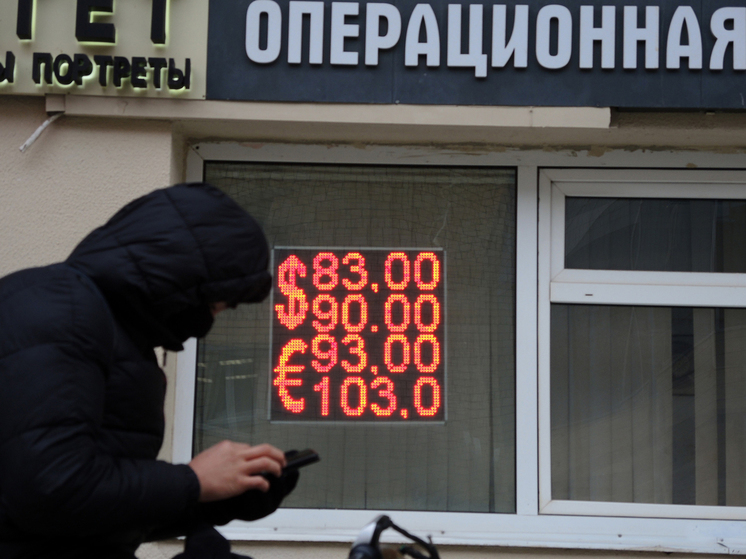The fall of the ruble in June, economists called abnormal
[ad_1]

Something very strange happens to the ruble in June: the rate is steadily flying down for no apparent external reasons. It is absolutely incomprehensible why right now the Russian currency began to weaken so sharply and uncontrollably. After all, in May, when the ruble held up well against the dollar and the euro, exactly the same factors worked against it as today: geopolitical uncertainty, a budget deficit of 3.4 trillion rubles, a reduction in oil and gas revenues, and a poor state of the trade and payment balance.
Miracles with a minus sign began on Friday, June 9 (the dollar exchange rate for the first time since April 7 exceeded the mark of 83 rubles) and continued on Wednesday, June 14: the weakening of the Russian currency accelerated on the Moscow Exchange to levels of 84.67 per dollar and to 91.31 for the euro. At the same time, according to analysts, if it were not for the emergency sale of the yuan by the Ministry of Finance, the fall of the ruble would have been even more serious.
Moreover, it will not be possible to write off what is happening on oil that is getting cheaper: its quotes have retreated from local lows and the Brent grade is trading above $74.5 per barrel.
The June situation was a continuation of the general long-term trend towards the weakening of the national currency. As the Central Bank said in its regular report, since the beginning of 2023, the real effective exchange rate of the ruble (calculated against the currencies of major trading partners, adjusted for inflation) has fallen by 18%. In October 2022, the dollar cost 55-57 rubles, today it is 84. And this is by no means the limit. The central bank tightened its signal last week, allowing a rate hike at its next meeting and pointing to high pro-inflationary risks.
“Today, several factors are working against the ruble,” says Nikita Maslennikov, a leading expert at the Center for Political Technologies. – The most fundamental: a significant deterioration in the trade and balance of payments. The current account surplus in January-May 2023 decreased four times, according to the Central Bank, amounting to $22.8 billion against $123.8 billion a year ago. Since the spring of 2022, the situation has completely reversed: then the volume of exports of Russian goods (and prices for them) grew, while imports fell, today the opposite is true. Accordingly, last year’s scenario with the strengthening of the ruble is unlikely to be repeated in the foreseeable future.
Other market factors working against the ruble include, firstly, the end of the tax period in Russia (the ruble traditionally weakens after the completion of tax payments by companies), and secondly, the high volatility of oil prices (this week they fell to $72 per barrel), thirdly, the nervousness of investors about the expected decision of the US Federal Reserve on the key rate (if the rate continues to rise, the dollar will strengthen its position), fourthly, the reaction of market players to information related to the expected 11th package of EU sanctions , as well as with the risks of secondary sanctions against partner countries of the Russian Federation.
According to Maslennikov, today the factor of the weakening ruble affects inflation much faster and harder than last year: if then the effect stretched over several quarters, now it manifests itself within a month or two.
“Support for the ruble can be provided by a new tax period (taxes must be paid in rubles, and currency must be discounted), as well as the fact that from July 1, Saudi Arabia will reduce daily oil production by another 1 million barrels and theoretically whip up prices for raw materials. And then the rate, which in June is behaving obviously anomalously, can return to the corridor of 78-83 per dollar,” the expert argues.
The situation on the foreign exchange market remains unstable and depends on many factors, including geopolitical risks, energy costs, Russian budget indicators and decisions of regulators (the US Federal Reserve, the European Central Bank and the Bank of Russia). The ruble may return to growth if, say, oil rises in price to $100 per barrel, the Central Bank raises the rate above 10% per annum, and the Russian treasury deficit decreases, BitRiver financial analyst Vladislav Antonov believes.
Well, for ordinary citizens who are far from the financial market, the question is relevant: what is happening in bank currency exchange offices against the backdrop of recent events with the ruble, how actively do people buy dollars and euros, and are there banknotes available? As we found out by calling several metropolitan banks, there is no shortage of “unfriendly” banknotes, just as there is no mass influx of people who want to acquire them.
Western currency is taken more often now, but not because the ruble is weakening, but because of summer holidays and plans to go on vacation abroad – to Turkey, Egypt, somewhere else where the dollar and the euro are still in value. The values in the exchangers do not differ much from the central bank benchmarks. The average selling rate of the dollar is 85, the euro is 91.
[ad_2]
Source link






